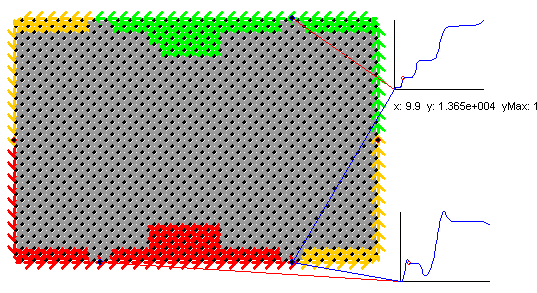

In this example special situations occur if the fillingfator outside
the gate is n = 4 and n
=
2 because in this cases the fillingfactor below the gate gets
nG
=
2 and nG
=1 respectively. This
means for n = 4 two edge channels get transmitted
through the gate and 2 edge channels get reflected. In the case n
=
2 one edge channel gets transmitted and one reflected. The simulation shows
the potential distribution in the second Landau level while the magnetic
field sweeps in a way that the fillingfactor n
changes from above n = 4 to n
=
2. This means that at the beginning of the sweep the 2nd Landau level should
create a transmitted EC while at the end it should create a reflected EC.
The Hall resistance and the longitudinal resistance are shown on the right.
The actual position of the magnetic field is spotted by the red circle
on the curves. According to the Landauer-Büttiker formalism Rxx
and Rxy get identical, if the ration between reflection and
transmission is one. This is the case if n =
4 and if n
= 2, where therefore Rxx
also forms plateaus like Rxy . According to this the n
=
4 plateau and the n
= 2 plateau are reproduced
also by Rxx . In the intermediate regime the gated region performs
a transition to the insulating state, which can be seen in the change of
the potential gradient from the transvers to the the longitudinal direction.
This behavior can be also seen like a HI-transition which partially takes
place below the gate in the 2nd LL: